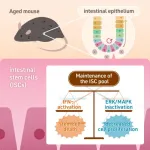(Press-News.org) Neuroscientists have new insights into why previous experiences influence future behaviors. Experiments in mice reveal that personal history, especially stressful events, influences how the brain processes whether something is positive or negative. These calculations ultimately impact how motivated a rodent is to seek social interaction or other kinds of rewards.
In a first of its kind study, Tufts University School of Medicine researchers demonstrate that interfering with the neural circuits responsible for emotional decisions can increase or decrease socially avoidant behaviors in mice, regardless of whether they had enriched or adverse experiences as pups. The findings, appearing February 13 in the Journal of Neuroscience, suggest that antisocial behaviors associated with childhood neglect or related forms of abuse may result from dysfunctional dopamine signaling in the midbrain.
Many aspects of motivation involve dopamine, the neurotransmitter responsible for pleasurable feelings. When a mammal does something that enhances the chances of survival, such as eat a tasty meal or engage in sex, dopamine levels surge. In humans (and mice), positive social interactions are generally rewarded by a burst of activity in the ventral tegmental area—a pathway of dopamine-releasing neurons. It connects the basolateral amygdala, a clump of nerves in the midbrain where emotions are processed, to the prefrontal cortex, where the brain makes critical decisions surrounding emotion and motivation.
“If people with early life stress are losing the ability to send information from parts of the brain that are needed for motivated behaviors, it made sense that we’d see less crosstalk between these two areas,” says first author Bradly Stone, who conducted the research as a Tufts postdoctoral scholar. “The result that turned our heads was that early life stress reduces the number of dopaminergic neurons between the ventral tegmental area and basolateral amygdala, suggesting that network architecture is impaired.”
To test this hypothesis, Stone and his colleagues leveraged cutting-edge laboratory techniques that allowed them to artificially activate or silence dopamine inputs into the basolateral amygdala from the ventral tegmental area. They applied this to a classic behavioral protocol in which a mouse is given the choice to investigate chambers with either a toy or a stranger mouse. Mice with carefree early days visited the stranger mouse as expected. However, mice that experienced maternal neglect primarily opted to do nothing or interact with the toy. This was only revealed when the investigators activated the dopaminergic neurons between the ventral tegmental area and basolateral amygdala. Importantly, when dopaminergic neurons were turned off in animals with carefree early days, they started behaving like animals who grew up with maternal neglect.
“This experiment was a beautiful part to this story that really made me believe in the work,” says Stone. “It’s evidence that social avoidance is governed by a delicate balance of interconnected neural elements and early life stress shapes these connections in a nuanced way that impairs their ability to function.”
END
Tufts researchers discover how experiences influence future behavior
School of Medicine researchers manipulate neural circuits in mice that make social interaction more or less rewarding
2025-02-13
ELSE PRESS RELEASES FROM THIS DATE:
Engineers discover key barrier to longer-lasting batteries
2025-02-13
Lithium nickel oxide (LiNiO2) has emerged as a potential new material to power next-generation, longer-lasting lithium-ion batteries. Commercialization of the material, however, has stalled because it degrades after repeated charging.
University of Texas at Dallas researchers have discovered why LiNiO2 batteries break down, and they are testing a solution that could remove a key barrier to widespread use of the material. They published their findings online Dec. 10 in the journal Advanced Energy Materials.
The team plans first to manufacture LiNiO2 batteries in the lab and ...
SfN announces Early Career Policy Ambassadors Class of 2025
2025-02-13
WASHINGTON — The Society for Neuroscience (SfN) has selected 10 members from a highly competitive applicant pool to participate in the Society’s annual Capitol Hill Day on March 11–13, 2025. The 10 Early Career Policy Ambassadors (ECPAs), representing many career stages and geographic locations, were chosen for their dedication to advocating for the scientific community, their desire to learn more about effective means of advocacy, and their experience as leaders in their labs and community.
The ambassadors are:
Izan Chalen, University of Illinois Urbana-Champaign
Nicole D’Souza, University of California, Riverside
Lana Ruvolo Grasser, PhD, Department ...
YOLO-Behavior: A new and faster way to extract animal behaviors from video
2025-02-13
Collecting video data is the long-established way biologists collect data to measure the behaviour of animals and humans. Videos might be taken of human subjects sitting in front of a camera while eating in a group in the University of Konstanz, or researchers using cameras to measure how often house sparrow parents visit their nests on Lundy Island, UK. All these video datasets have one thing in common: after collecting them, researchers need to painstakingly watch each video, manually mark down who, where and when each behaviour of interest happens—a process known as “annotation”. ...
Researchers identify a brain circuit for creativity
2025-02-13
KEY TAKEAWAYS
Brigham researchers analyzed data from 857 patients across 36 fMRI brain imaging studies and mapped a common brain circuit for creativity.
They derived the circuit in healthy individuals and then predicted which locations of brain injury and neurodegenerative disease might alter creativity.
The study found that changes in creativity in people with brain injury or neurodegenerative disease may depend on the location of injury in reference to the creativity circuit.
A new study led by ...
Trends in obesity-related measures among U.S. children, adolescents, and adults
2025-02-13
About The Study: From 2013-2014 to August 2021-August 2023, there were small increases in the percentage of children and adolescents with obesity, as well as in adults with severe obesity (but not obesity). There were no other significant changes in obesity-related measures, including waist circumference. This period included the COVID-19 pandemic; a study using electronic health records found a small increase in mean weight among adults during the pandemic.
Corresponding Author: To contact the corresponding author, Samuel D. Emmerich, DVM, email semmerich@cdc.gov.
To access ...
U.S. abortion bans and fertility
2025-02-13
About The Study: The findings of this study provide evidence that fertility rates in states with abortion bans were higher than would have been expected in the absence of these policies, with the largest estimated differences among subpopulations experiencing the greatest structural disadvantages and in states with among the worst maternal and child health and well-being outcomes.
Corresponding Author: To contact the corresponding author, Suzanne O. Bell, PhD, email suzannebell@jhu.edu.
To ...
U.S. abortion bans and infant mortality
2025-02-13
About The Study: U.S. states that adopted abortion bans had higher than expected infant mortality after the bans took effect. The estimated relative increases in infant mortality were larger for deaths with congenital causes and among groups that had higher than average infant mortality rates at baseline, including Black infants and those in southern states.
Corresponding Author: To contact the corresponding author, Alison Gemmill, PhD, email agemmill@jhu.edu.
To access the embargoed study: Visit our For The Media website at this link https://media.jamanetwork.com/
(doi:10.1001/jama.2024.28517)
Editor’s ...
Safeguarding intestinal stem cells during aging through balanced signaling
2025-02-13
A recent study led by Associate Professor Takuya Yamamoto and Researcher May Nakajima-Koyama has revealed that maintaining a delicate balance between interferon-gamma (IFN-γ) and extracellular signal-regulated kinase (ERK)/mitogen-activated protein kinase (MAPK) signaling is essential for preserving the intestinal stem cell population during aging. By comparing young and aged mouse intestinal tissues, the researchers uncovered critical insights into the interplay between these signaling pathways in supporting stem cell maintenance over time.
The intestinal epithelium exhibits the highest cell ...
How fruit flies flit between courtship and aggression to fight for mates
2025-02-13
For fruit flies, finding the right mate is all about the right song. Now, research shows that male flies don’t just try to impress their valentine by serenading her with song—they also go to great lengths to drown out the competition. By jamming their rivals’ love songs with high-frequency wing flicks, male fruit flies boost the chances that they’ll win the female over.
The new study, published in Cell, explains how the fruit fly brain coordinates courtship and aggressive competition—a framework which could ultimately help scientists understand how humans flexibly ...
Carbon emission drivers in the Belt and Road Initiative countries—An empirical analysis based on countries with different income levels
2025-02-13
With the promotion of the "the Belt and Road" initiative, the economy and society of BRI countries have developed rapidly, but they are also facing severe challenges of rising carbon emissions. Many countries rely on fossil fuels, and the process of energy transition is slow. Coupled with insufficient financial and technological support, especially low-income countries that have limited access to global climate funds, they face greater difficulties in the low-carbon transformation process.
To identify the carbon emission drivers at different development stages of BRI countries ...
LAST 30 PRESS RELEASES:
Scalable and healable gradient textiles for multi‑scenario radiative cooling via bicomponent blow spinning
Research shows informed traders never let a good climate crisis go to waste
Intelligent XGBoost framework enhances asphalt pavement skid resistance assessment
Dual-function biomaterials for postoperative osteosarcoma: Tumor suppression and bone regeneration
New framework reveals where transport emissions concentrate in Singapore
NTP-enhanced lattice oxygen activation in Ce-Co catalysts for low-temperature soot combustion
Synergistic interface engineering in Cu-Zn-Ce catalysts for efficient CO2 hydrogenation to methanol
COVID-19 leaves a lasting mark on the human brain
Scientists use ultrasound to soften and treat cancer tumors without damaging healthy tissue
Community swimming program for Black youth boosts skills, sense of belonging, study finds
Specific depressive symptoms in midlife linked to increased dementia risk
An ‘illuminating’ design sheds light on cholesterol
Who is more likely to get long COVID?
Study showcases resilience and rapid growth of “living rocks”
Naval Research Lab diver earns Office of Naval Research 2025 Sailor of the Year
New Mayo-led study establishes practical definition for rapidly progressive dementia
Fossil fuel industry’s “climate false solutions” reinforce its power and aggravate environmental injustice
Researchers reveal bias in a widely used measure of algorithm performance
Alcohol causes cancer. A study from IOCB Prague confirms damage to DNA and shows how cells defend against it
Hidden viruses in wastewater treatment may shape public health risks, study finds
Unlock the power of nature: how biomass can transform climate mitigation
Biochar reshapes hidden soil microbes that capture carbon dioxide in farmland
Reducing saturated fat intake shows mortality benefit, but only in high-risk individuals
Manta rays create mobile ecosystems, study finds
Study: Mixed results in using lipoic acid to treat progressive multiple sclerosis
Norbert Holtkamp appointed director of Fermi National Accelerator Laboratory
New agentic AI platform accelerates advanced optics design
Biologists discover neurons use physical signals — not electricity — to stabilize communication
Researchers discover that a hormone can access the brain by hitchhiking
University of Oklahoma researcher awarded funding to pursue AI-powered material design
[Press-News.org] Tufts researchers discover how experiences influence future behaviorSchool of Medicine researchers manipulate neural circuits in mice that make social interaction more or less rewarding



